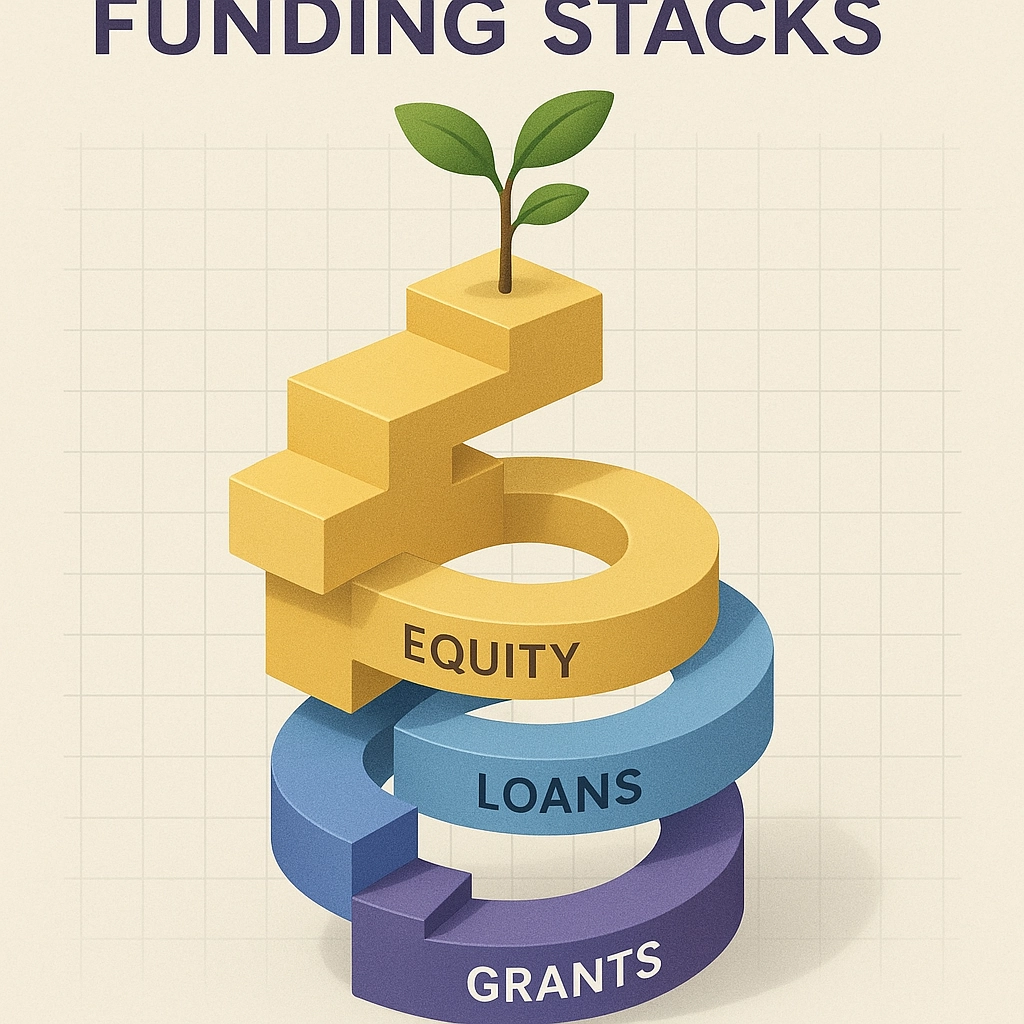
Funding Your Next Chapter: Creative Financing Options for Startups and Non-Profits in 2025
The quest for capital remains one of the most challenging aspects of launching and scaling both startups and non-profit organizations. As we move deeper into 2025, the good news is that the funding ecosystem has expanded far beyond traditional bank loans and venture capital. Creative financing options are democratizing access to capital, offering innovative pathways tailored to different organizational structures, missions, and growth stages.
Whether you're a tech startup with ambitious growth plans or a community-focused non-profit with a passion for social change, understanding the full spectrum of today's funding options is crucial for your success. Let's explore the most promising financing avenues available right now.
Grants: Free Money Isn't a Myth (But It Is Competitive)
Grants remain the holy grail of funding—money you don't have to repay. However, they're notoriously competitive, with acceptance rates hovering around 10%. The key is knowing where to look and how to position your organization:
Federal Grant Programs
- Small Business Innovation Research (SBIR): Provides early-stage funding for tech innovations with commercial potential
- Small Business Technology Transfer (STTR): Similar to SBIR but requires collaboration with research institutions
- Economic Development Administration (EDA) Grants: Focuses on economically distressed communities and job creation
State and Local Opportunities
Many states have established their own grant programs to foster local economic development:
- Innovation Grants: States like Massachusetts and Colorado offer innovation-focused grants targeting specific industries
- Economic Development Funds: Often available through regional development authorities
- Local Community Foundation Grants: Perfect for non-profits addressing community-specific needs

Corporate and Foundation Grants
Some of the most accessible grant opportunities come from corporations and private foundations:
- Corporate Social Responsibility (CSR) Programs: Many major companies allocate funds to support startups and non-profits aligned with their values
- Industry-Specific Foundation Grants: Organizations like the Kaufman Foundation (entrepreneurship) or Gates Foundation (global development)
- Demographic-Focused Grants: Programs specifically for women founders, BIPOC entrepreneurs, veteran-owned businesses, and other underrepresented groups
Pro Tip: Before applying for any grant, thoroughly research the funder's priorities and tailor your application to demonstrate direct alignment with their mission. For personalized guidance on identifying the right grants for your organization, check out our Funding Strategy Plan.
Alternative Financing Models: Beyond Traditional Loans
When conventional financing isn't available or doesn't fit your needs, these alternatives offer compelling solutions:
Crowdfunding: More Than Just Capital
Crowdfunding has evolved into a sophisticated funding channel that offers multiple benefits:
- Validation: Proves market demand before fully launching
- Marketing: Creates early buzz and a customer base
- Flexibility: Various models including rewards-based, equity, and donation platforms
Best for: Consumer products, creative projects, and cause-driven initiatives with compelling stories
Revenue-Based Financing
This increasingly popular option provides capital in exchange for a percentage of future revenue:
- No equity dilution: Maintain full ownership of your business
- Flexible repayment: Payments scale with your revenue
- Faster access: Often quicker than traditional loans with less paperwork
Best for: Companies with established revenue streams and healthy margins
Community Development Financial Institutions (CDFIs)
CDFIs specialize in serving businesses and non-profits in underserved communities:
- Mission-aligned: Focused on economic development and social impact
- Flexible terms: Often more accommodating than traditional banks
- Additional support: Many offer technical assistance alongside funding
Best for: Organizations serving low-income communities or those unable to access traditional bank financing

Creative Financing Specifically for Non-Profits
Non-profit organizations have unique funding challenges and opportunities:
Program-Related Investments (PRIs)
These investments come from foundations and operate similar to loans but with favorable terms:
- Below-market interest rates: Often significantly lower than commercial loans
- Flexible repayment: Customized to the non-profit's cash flow
- Mission alignment: Must advance the foundation's charitable purpose
Corporate Sponsorships and Partnerships
Beyond one-time donations, strategic corporate partnerships can provide sustainable funding:
- Event sponsorships: Support for fundraising events or programs
- Cause marketing: Joint promotional campaigns benefiting both parties
- In-kind donations: Services, expertise, or products that reduce operational costs
Donor-Advised Funds (DAFs)
The fastest-growing giving vehicle in philanthropy:
- $160 billion+: Current total assets in DAFs available for charitable giving
- Strategic targeting: Identify and cultivate relationships with DAF advisors
- Larger gifts: Average DAF grant is significantly higher than typical donations
Non-Profit Funding Accelerator: For non-profit leaders looking to diversify their funding sources, our Funding Accelerator Program provides a comprehensive roadmap to sustainable financing.
State-Specific Programs: Local Resources with Major Impact
Don't overlook state and regional funding programs designed to boost local economies:
State-Sponsored Venture Funds
Many states have established investment funds specifically targeting local startups:
- Michigan's Renaissance Venture Capital Fund: Invests in companies committed to growing in Michigan
- Georgia Venture Capital Fund: Focuses on early-stage technology companies
- Massachusetts Clean Energy Center: Provides funding for clean energy innovations
Economic Development Loans
These programs often offer better terms than commercial loans:
- Job creation incentives: Funding tied to employment growth
- Rural development programs: Specialized support for businesses outside urban centers
- Industry-specific initiatives: Targeted funding for priority sectors like advanced manufacturing or healthcare
Equity Financing: When and How to Give Up a Slice
For high-growth startups, equity financing remains a powerful option:
Angel Investors: More Than Just Money
Individual investors can provide crucial early capital along with expertise:
- Network access: Connections to customers, partners, and future investors
- Mentorship: Business guidance from experienced entrepreneurs
- Flexibility: Often more accommodating terms than institutional investors
Venture Capital: Fuel for Hypergrowth
When rapid expansion is the goal, venture capital provides the necessary resources:
- Series funding: From seed rounds to Series A, B, and beyond
- Industry expertise: VC firms often specialize in specific sectors
- Growth infrastructure: Support for scaling operations, hiring, and market expansion
Strategy Note: Equity financing means giving up ownership and some control. Before pursuing this path, be clear about your long-term vision and how investors fit into that picture. Our team can help you evaluate if equity financing aligns with your goals through our Funding Strategy Plan.

Building Your Funding Stack: The Hybrid Approach
The most successful organizations rarely rely on a single funding source. Instead, they build a strategic "funding stack" that combines multiple options:
The Startup Example
A typical early-stage startup might leverage:
- Founder savings and friends/family investments to build an MVP
- Angel funding or accelerator program for initial market traction
- Revenue-based financing to fund marketing and inventory
- Venture capital for significant expansion
The Non-Profit Example
A growing non-profit might utilize:
- Foundation grants for program development
- Corporate partnerships for operational funding
- Individual donor campaigns for specific initiatives
- Program-related investments for capital projects
Preparing for Funding Success
No matter which funding options you pursue, preparation is crucial:
Fundability Assessment
Before approaching any funding source, ensure your organization is positioned for success:
- Financial readiness: Clean books, reasonable projections, and transparent reporting
- Legal structure: Appropriate entity type for your goals (benefit corporation, 501(c)(3), etc.)
- Leadership team: Demonstrated expertise and capability to execute
Compelling Storytelling
All funders—whether grant-makers, investors, or donors—respond to powerful narratives:
- Clear problem statement: The specific challenge you're addressing
- Unique solution: What makes your approach different and effective
- Measurable impact: How you define and track success
For a comprehensive assessment of your organization's funding readiness, consider our Funding Strategy Plan.
The Mindset Factor: Overcoming Funding Hurdles
Often, the biggest barrier to securing funding isn't external—it's our relationship with money itself. Many founders and non-profit leaders struggle with:
- Scarcity thinking: Believing there's not enough funding available
- Imposter syndrome: Feeling unworthy of investment or support
- Risk aversion: Fear of taking on appropriate financing
Addressing these mindset challenges is essential for funding success. Our Money Mindset Masterclass helps leaders develop a healthier relationship with money and funding.
Taking Action: Your Next Steps
The funding landscape of 2025 offers more possibilities than ever before. To make the most of these opportunities:
- Assess your current situation: Where are you now, and what resources do you need?
- Clarify your funding strategy: Which options align with your mission, structure, and growth plans?
- Prepare systematically: Develop the materials, metrics, and messaging each funding source requires
- Build relationships early: Connect with potential funders before you need their support
Conclusion
Funding your startup or non-profit doesn't have to be an insurmountable challenge. By exploring creative financing options and developing a strategic approach, you can secure the resources needed to bring your vision to life. The key is matching the right funding sources to your specific situation and needs.
At New Day For You Financial, we specialize in helping organizations navigate the complex funding landscape. Ready to explore your options? Schedule a consultation with our team to develop your customized funding roadmap.
Your next chapter of growth is waiting—let's find the right financing to make it happen.

Imagine having all the tools & support you ever needed to start your dream business... today.
I'm talking not only heftier numbers in that bank account. I'm talking the freedom to do what you want, when you want, because you can work however you want, whenever you want.















